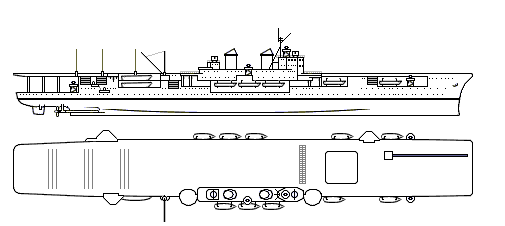The SAE offers to lay down an additional vessel of a class of two planned for the RSAN. A slip is available, payment details can be discussed. The offer includes a training program for Peru's naval pilots together with SAE classes aboard the Michel Endress.
CVL43-A, South Africa Light Carrier laid down 1943
Displacement:
13.992 t light; 14.490 t standard; 17.144 t normal; 19.268 t full load
Dimensions: Length overall / water x beam x draught
670,20 ft / 656,17 ft x 68,90 ft x 25,52 ft (normal load)
204,28 m / 200,00 m x 21,00 m x 7,78 m
Armament:
8 - 4,53" / 115 mm guns (4x2 guns), 50,71lbs / 23,00kg shells, 1943 Model
Dual purpose guns in deck mounts with hoists
on side, all amidships, all raised mounts - superfiring
16 - 2,95" / 75,0 mm guns in single mounts, 13,23lbs / 6,00kg shells, 1943 Model
Automatic rapid fire guns in deck mounts with hoists
on side, all amidships, all raised mounts - superfiring
20 - 0,79" / 20,0 mm guns in single mounts, 0,24lbs / 0,11kg shells, 1943 Model
Machine guns in deck mounts
on side, evenly spread, all raised mounts
Weight of broadside 622 lbs / 282 kg
Shells per gun, main battery: 400
Armour:
- Belts: Width (max) Length (avg) Height (avg)
Main: 3,15" / 80 mm 485,56 ft / 148,00 m 9,84 ft / 3,00 m
Ends: Unarmoured
Main Belt covers 114% of normal length
- Torpedo Bulkhead:
1,38" / 35 mm 485,56 ft / 148,00 m 25,43 ft / 7,75 m
- Gun armour: Face (max) Other gunhouse (avg) Barbette/hoist (max)
Main: 1,97" / 50 mm 1,97" / 50 mm 3,15" / 80 mm
2nd: 1,18" / 30 mm 1,18" / 30 mm 1,18" / 30 mm
- Armour deck: 3,15" / 80 mm, Conning tower: 0,79" / 20 mm
Machinery:
Oil fired boilers, steam turbines,
Geared drive, 4 shafts, 120.000 shp / 89.520 Kw = 33,55 kts
Range 12.000nm at 18,00 kts
Bunker at max displacement = 4.778 tons
Complement:
748 - 973
Cost:
£6,474 million / $25,895 million
Distribution of weights at normal displacement:
Armament: 78 tons, 0,5%
Armour: 3.214 tons, 18,7%
- Belts: 617 tons, 3,6%
- Torpedo bulkhead: 629 tons, 3,7%
- Armament: 96 tons, 0,6%
- Armour Deck: 1.860 tons, 10,8%
- Conning Tower: 11 tons, 0,1%
Machinery: 3.099 tons, 18,1%
Hull, fittings & equipment: 5.100 tons, 29,7%
Fuel, ammunition & stores: 3.153 tons, 18,4%
Miscellaneous weights: 2.500 tons, 14,6%
Overall survivability and seakeeping ability:
Survivability (Non-critical penetrating hits needed to sink ship):
24.024 lbs / 10.897 Kg = 517,7 x 4,5 " / 115 mm shells or 3,5 torpedoes
Stability (Unstable if below 1.00): 1,15
Metacentric height 3,7 ft / 1,1 m
Roll period: 15,0 seconds
Steadiness - As gun platform (Average = 50 %): 52 %
- Recoil effect (Restricted arc if above 1.00): 0,11
Seaboat quality (Average = 1.00): 1,04
Hull form characteristics:
Hull has a flush deck
and transom stern
Block coefficient: 0,520
Length to Beam Ratio: 9,52 : 1
'Natural speed' for length: 29,28 kts
Power going to wave formation at top speed: 58 %
Trim (Max stability = 0, Max steadiness = 100): 50
Bow angle (Positive = bow angles forward): 20,00 degrees
Stern overhang: 3,28 ft / 1,00 m
Freeboard (% = measuring location as a percentage of overall length):
- Stem: 29,53 ft / 9,00 m
- Forecastle (20%): 20,34 ft / 6,20 m
- Mid (50%): 20,34 ft / 6,20 m
- Quarterdeck (15%): 20,34 ft / 6,20 m
- Stern: 20,34 ft / 6,20 m
- Average freeboard: 21,08 ft / 6,42 m
Ship space, strength and comments:
Space - Hull below water (magazines/engines, low = better): 111,9%
- Above water (accommodation/working, high = better): 165,3%
Waterplane Area: 31.919 Square feet or 2.965 Square metres
Displacement factor (Displacement / loading): 137%
Structure weight / hull surface area: 102 lbs/sq ft or 500 Kg/sq metre
Hull strength (Relative):
- Cross-sectional: 0,97
- Longitudinal: 1,25
- Overall: 1,00
Hull space for machinery, storage, compartmentation is cramped
Room for accommodation and workspaces is excellent
The vessel is designed to carry 48 a/c (4 squadrons of 12 each) for 2304 tons of misc weight. 196 tons can be used for spares, special equipment, electronics, staff facilities or growth reserve.
[The ships size offers enough hangar space for 60 planes according to SS rules. As the rules do not specify whether the planes carried are big or small, I assume hangar space allows the use of twin engine a/c.]
Is Peru also interested in buying shipborne a/c abroad or will home grown designs be used?


Quoted
Originally posted by BrockpaineQuoted
Originally posted by Red AdmiralQuoted
Originally posted by Brockpaine